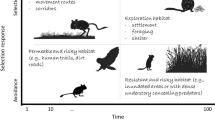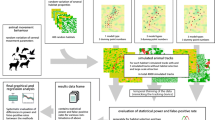Abstract
Context
Incorporating hard and soft barriers into individual space-use measures in wildlife tracking studies remains an ongoing challenge in movement ecology.
Objectives
Randomized shortest paths are proposed as a new tool for estimating wildlife utilization distributions—termed the RSPUD.
Methods
The RSPUD model requires a single parameter (θ) which controls the trade-off between random exploration of the landscape and deterministic movement along the least-cost path. Synthetic data are used to demonstrate the flexibility of RSPUDs across a range of scenarious that could be encountered with wildlife tracking data. A case-study using GPS tracking data of an individual caribou (Rangifer tarandus) in British Columbia, Canada is used to demonstrate the method in an applied setting.
Results
The synthetic data examples highlight the properties of RSPUD across a range or scenarios. In the empirical data, we found that the RPSUD method more appropriately delineated individual space use and the avoidance of obvious barriers on the landscape in comparison to the Brownian bridge model.
Conclusions
The calculation of RSPUDs provides new opportunities for more sophisticated spatial analysis of individual measures of space use (home range and utilization distributions), by explicitly taking into consideration the role of hard and soft barriers constraining individual movement opportunities. The approach should be attractive to movement ecologists as it takes a similar approach to existing methods (e.g., Brownian bridges and biased random bridges). The method is made accessible to other researchers as part of the wildlifeTG R package.







Similar content being viewed by others
References
Ahearn SC, Dodge S, Simcharoen A, Xavier G, Smith JL (2017) A context-sensitive correlated random walk: a new simulation model for movement. Int J Geogr Inf Sci 31(5):867–883
Avgar T, Potts JR, Lewis MA, Boyce MS (2016) Integrated step selection analysis: bridging the gap between resource selection and animal movement. Methods Ecol Evol 7(5):619–630 1011.1669v3
Bateman AW, Lewis MA, Gall G, Manser MB, Clutton-Brock TH (2015) Territoriality and home-range dynamics in meerkats, Suricata suricatta: a mechanistic modelling approach. J Anim Ecol 84(1):260–271
Benhamou S (2011) Dynamic approach to space and habitat use based on biased random bridges. PLoS ONE 6(1):e14592
Benhamou S, Cornélis D (2010) Incorporating movement behavior and barriers to improve kernel home range space use estimates. J Wildl Manag 74(6):1353–1360
Beyer HL, Gurarie E, Börger L, Panzacchi M, Basille M, Herfindal I, Van Moorter B, Lele RS (2014) ’You Shall Not Pass!’: quantifying barrier permeability and proximity avoidance by animals. J Anim Ecol 85(1):43–53
Calenge C (2006) The package “Adehabitat” for the R Software: a tool for the analysis of space and habitat use by animals. Ecol Model 197(3–4):516–519
Clapp JG, Beck JL (2015) Evaluating distributional shifts in home range estimates. Ecol Evol 5(18):3869–3878
Douglas DH (1994) Least-cost path in GIS using an accumulated cost surface and slopelines. Cartographica 31(3):37–51
Fleming CH, Fagan WF, Mueller T, Olson KA, Leimgruber P, Calabrese JM (2015) A new autocorrelated kernel density estimator. Ecology 96(5):1182–1188
Fullman TJ, Joly K, Ackerman A (2017) Effects of environmental features and sport hunting on Caribou migration in Northwestern Alaska. Mov Ecol 5(1):1–11
Gaspar P, Georges JY, Fossette S, Lenoble A, Ferraroli S, Le Maho Y (2006) Marine animal behaviour: neglecting ocean currents can lead us up the wrong track. Proc R Soc B Biol Sci 273(1602):2697–2702
Harel R, Duriez O, Spiegel O, Fluhr J, Horvitz N, Getz WM, Bouten W, Sarrazin F, Hatzofe O, Nathan R (2016) Decision-making by a soaring bird: time, energy and risk considerations at different spatio-temporal scales. Philos Trans R Soc B Biol Sci 371(1704):1–11
Horne JS, Garton EO, Krone SM, Lewis JS (2007) Analyzing animal movements using Brownian bridges. Ecology 88(9):2354–2363
Keeley ATH, Beier P, Gagnon JW (2016) Estimating landscape resistance from habitat suitability: effects of data source and nonlinearities. Landscape Ecol 31(9):2151–2162
Kivimäki I, Shimbo M, Saerens M (2014) Developments in the theory of randomized shortest paths with a comparison of graph node distances. Physica A 393:600–616
Knight C, Kenward R, Gozlan R, Hodder K, Walls S, Lucas M (2009) Home range estimation within complex restricted environments: importance of method selection in detecting seasonal change. Wildl Res 36(3):213–224
Kranstauber B, Kays R, Lapoint SD, Wikelski M, Safi K (2012) A dynamic Brownian bridge movement model to estimate utilization distributions for heterogeneous animal movement. J Anim Ecol 81(4):738–46
Langrock R, King R, Matthiopoulos J, Thomas L, Fortin D, Morales JM (2012) Flexible and practical modeling of animal telemetry data: hidden Markov models and extensions. Ecology 93(11):2336–2342
LaPoint S, Gallery P, Wikelski M, Kays R (2013) Animal behavior, cost-based corridor models, and real corridors. Landscape Ecol 28(8):1615–1630
Lawler JJ, Ruesch AS, Olden JD, McRae BH (2013) Projected climate-driven Faunal movement routes. Ecol Lett 16(8):1014–1022
Le Roux M, Redon M, Archaux F, Long J, Vincent S, Luque S (2017) Conservation planning with spatially explicit models: a case for horseshoe bats in complex mountain landscapes. Landscape Ecol 32(5):1005–1021
Lindsay JB, Dhun K (2015) Modelling surface drainage patterns in altered landscapes using LiDAR. Int J Geogr Inf Sci 29(3):397–411
Long JA (2018) Modeling movement probabilities within heterogeneous spatial fields. J Spat Inf Sci 16(16):85–116
Long JA, Nelson TA (2012) Time geography and wildlife home range delineation. J Wildl Manag 76(2):407–413
Long JA, Nelson TA (2015) Home range and habitat analysis using dynamic time geography. J Wildl Manag 79(3):481–490
Manly B, McDonald L, Thomas D, McDonald T, Erickson W (2002) Resource selection by animals: statistical design and analysis for field studies, 2nd edn. Springer, Berlin
Matthiopoulos J (2003) Supervised kernel smoothing for the estimation of spatial usage. Oikos 102(2):367–377
Mattisson J, Persson J, Andrén H, Segerström P (2011) Temporal and spatial interactions between an obligate predator, the Eurasian Lynx (Lynx Lynx), and a facultative scavenger, the Wolverine (Gulo Gulo). Can J Zool 89(2):79–89
McClure ML, Hansen AJ, Inman RM (2016) Connecting models to movements: testing connectivity model predictions against empirical migration and dispersal data. Landscape Ecol 31(7):1419–1432
McGuire JL, Lawler JJ, McRae BH, Nuñez TA, Theobald DM (2016) Achieving climate connectivity in a fragmented landscape. Proc Natl Acad Sci USA 113(26):7195–7200
McRae BH, Dickson BG, Keitt TH, Shah VB (2008) Using circuit theory to model connectivity in ecology, evolution, and conservation. Ecology 89(10):2712–2724
Moorcroft PR, Lewis MA, Crabtree RL (2006) Mechanistic home range models capture spatial patterns and dynamics of coyote territories in Yellowstone. Proc R Soc B Biol Sci 273(1594):1651–1659
Morales J, Haydon D, Frair J, Holsinger KE, Fryxell JM (2004) Extracting more out of relocation data: building movement models as mixtures of random walks. Ecology 85(9):2436–2445
Neumann W, Martinuzzi S, Estes AB, Pidgeon AM, Dettki H, Ericsson G, Radeloff VC (2015) Opportunities for the application of advanced remotely-sensed data in ecological studies of terrestrial animal movement. Mov Ecol 3(1):1–13
Panzacchi M, Van Moorter B, Strand O, Saerens M, Kivimäki I, St Clair CC, Herfindal I, Boitani L (2016) Predicting the continuum between corridors and barriers to animal movements using step selection functions and randomized shortest paths. J Anim Ecol 85(1):32–42
Patterson TA, Basson M, Bravington MV, Gunn JS (2009) Classifying movement behaviour in relation to environmental conditions using hidden Markov models. J Anim Ecol 78(6):1113–1123
Patterson TA, Thomas L, Wilcox C, Ovaskainen O, Matthiopoulos J (2008) State-space models of individual animal movement. Trends Ecol Evol 23(2):87–94
Powell R, Mitchell MS (2012) What is a home range? J Mammal 93(4):948–958
Pullinger MG, Johnson CJ (2010) Maintaining or restoring connectivity of modified landscapes: evaluating the least-cost path model with multiple sources of ecological information. Landscape Ecol 25(10):1547–1560
Righton D, Mills C (2006) Application of GIS to investigate the use of space in coral reef fish: a comparison of territorial behaviour in two red sea butterflyfishes. Int J Geogr Inf Sci 20(2):215–232
Saerens M, Achbany Y, Fouss F, Yen L (2009) Randomized shortest-path problems: two related models. Neural Comput 21:2363–2404
Safi K, Kranstauber B, Weinzierl R, Griffin L, Rees EC, Cabot D, Cruz S, Proaño C, Takekawa JY, Newman SH, Waldenström J, Bengtsson D, Kays R, Wikelski M, Bohrer G (2013) Flying with the wind: scale dependency of speed and direction measurements in modelling wind support in avian flight. Mov Ecol 1(1):4–5
Sawyer SC, Epps CW, Brashares JS (2011) Placing linkages among fragmented habitats: do least-cost models reflect how animals use landscapes? J Appl Ecol 48(3):668–678
Schoby GP, Keeley ER (2011) Home range size and foraging ecology of bull trout and westslope cutthroat trout in the Upper Salmon River Basin, Idaho. Trans Am Fish Soc 140(3):636–645
Schumaker NH, Brookes A (2018) HexSim: a modeling environment for ecology and conservation. Landscape Ecol 33(2):197–211
Signer J, Fieberg J, Avgar T (2017) Estimating utilization distributions from fitted step-selection functions. Ecosphere 8(4):e01771
Smulders M, Nelson TA, Jelinski DE, Nielsen SE, Stenhouse GB, Laberee K (2012) Quantifying spatial-temporal patterns in wildlife ranges using STAMP: a grizzly bear example. Appl Geogr 35(1–2):124–131
Song Y, Miller HJ (2014) Simulating visit probability distributions within planar space-time prisms. Int J Geogr Inf Sci 28(1):104–125
Strandburg-Peshkin A, Farine DR, Couzin ID, Crofoot MC (2015) Shared decision-making drives collective movement in wild baboons. Science 348(6241):1358–1361
Technitis G, Othman W, Safi K, Weibel R (2015) From A to B, randomly: a point-to-point random trajectory generator for animal movement. Int J Geogr Inf Sci 29(6):912–934
Tracey JA, Sheppard J, Zhu J, Wei F, Swaisgood RR, Fisher RN (2014) Movement-based estimation and visualization of space use in 3D for wildlife ecology and conservation. PLoS ONE 9(7):e101205
Turchin P (1996) Fractal analyses of animal movement: a critique. Ecology 77(7):2086–2090
Van Etten J (2015) Gdistance: distances and routes on geographical grids (v 1.1-9). Tech Rep, R Foundation for Statistical Computing/R Foundation for Statistical Computing
van Toor ML, Kranstauber B, Newman SH, Prosser DJ, Takekawa JY, Technitis G, Weibel R, Wikelski M, Safi K (2018) Integrating animal movement with habitat suitability for estimating dynamic landscape connectivity. Landscape Ecol 33(6):879–893
Walter WD, Onorato DP, Fischer JW (2015) Is there a single best estimator? Selection of home range estimators using area-under-the-curve. Mov Ecol 3(1):1–11
Wang IJ, Savage WK, Shaffer HB (2009) Landscape genetics and least-cost path analysis reveal unexpected dispersal routes in the California tiger salamander (Ambystoma californiense). Mol Ecol 18(7):1365–1374
Wulder M, White J, Cranny M, Hall R, Luther J, Beaudoin A, Goodenough D, Dechka J (2008) Monitoring Canada’s forests-part 1: completion of the EOSD land cover project. Can J Remote Sens 34(6):549–562
Zeller KA, McGarigal K, Whiteley AR (2012) Estimating landscape resistance to movement: a review. Landscape Ecol 27(6):777–797
Zeller KA, McGarigal K, Beier P, Cushman SA, Vickers TW, Boyce WM (2014) Sensitivity of landscape resistance estimates based on point selection functions to scale and behavioral state: pumas as a case study. Landscape Ecol 29(3):541–557
Author information
Authors and Affiliations
Corresponding author
Additional information
Publisher's Note
Springer Nature remains neutral with regard to jurisdictional claims in published maps and institutional affiliations.
Electronic supplementary material
Below is the link to the electronic supplementary material.
Rights and permissions
About this article
Cite this article
Long, J.A. Estimating wildlife utilization distributions using randomized shortest paths. Landscape Ecol 34, 2509–2521 (2019). https://doi.org/10.1007/s10980-019-00883-y
Received:
Accepted:
Published:
Issue Date:
DOI: https://doi.org/10.1007/s10980-019-00883-y




